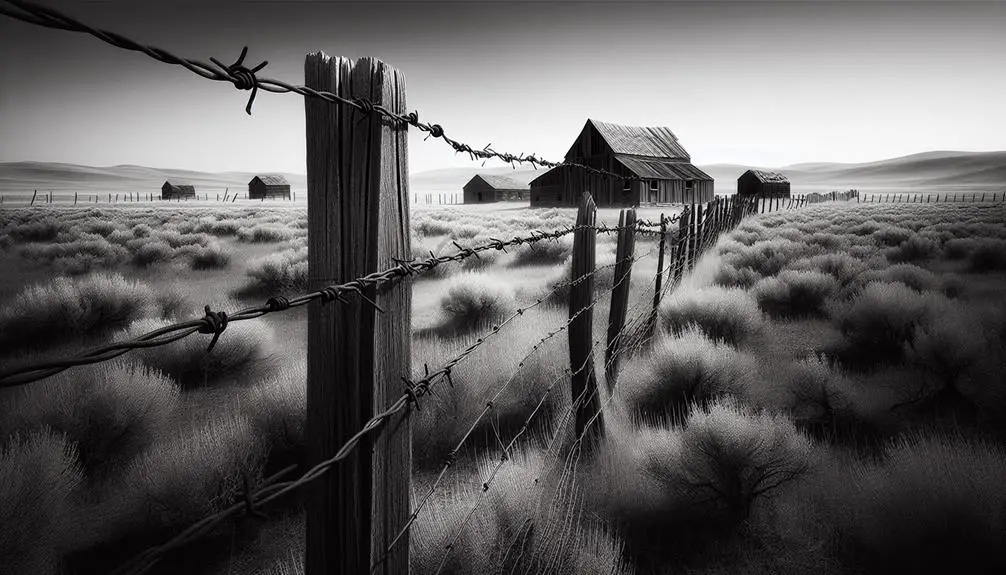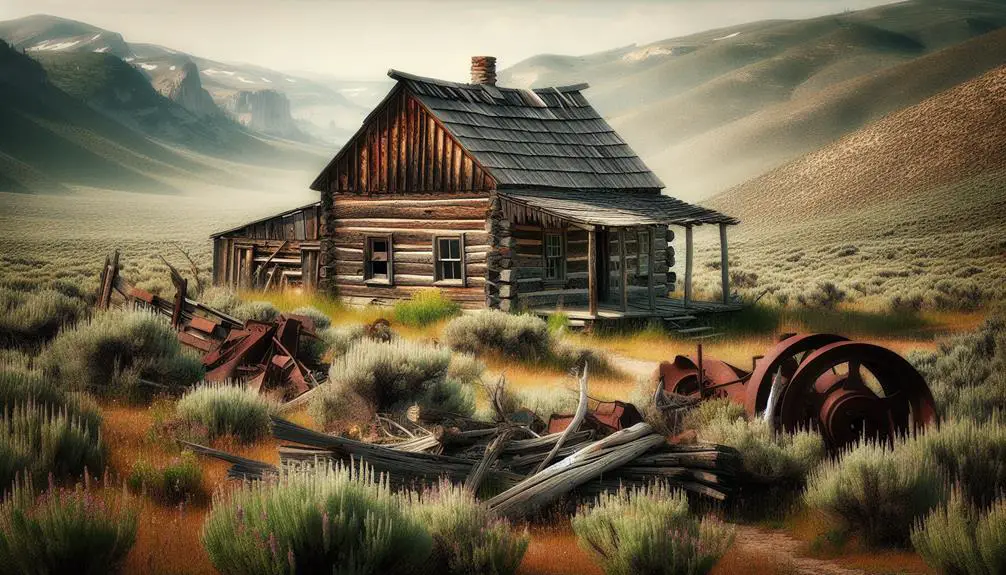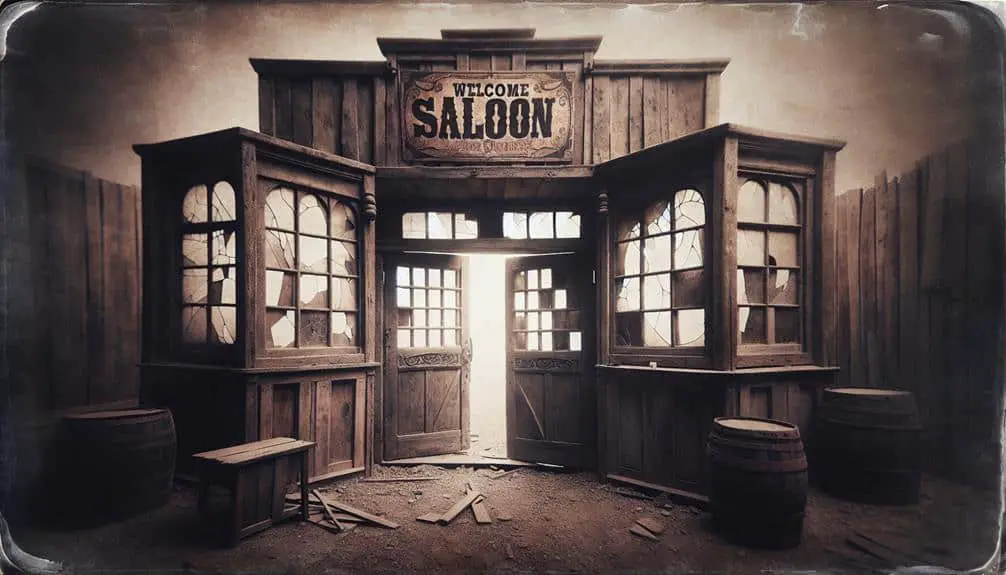Step into the forgotten world of abandoned ranching communities in America. Economic shifts, environmental struggles, and a lingering history have left these settlements frozen in time. From the tough frontier origins to the eerie tales of lost civilizations, each community tells a unique story of resilience and demise. Discover the rich legacy and preservation challenges of these ghostly towns that once thrived in the wilderness. Uncover the hidden secrets and whispered legends that shroud these desolate landscapes, hinting at a past waiting to be explored further.
Key Points
- Settlement due to economic opportunities and frontier expansion.
- Abandonment due to economic downturns, environmental challenges, and disasters.
- Legacy as eerie monuments reflecting past generations' struggles.
- Preservation requires strategic planning, heritage safeguarding, and revitalization efforts.
- Haunting tales of mysterious disappearances, ghostly apparitions, and chilling legends.
Origins of Forgotten Ranching Communities
The establishment of forgotten ranching communities across America can be attributed to a combination of economic opportunities, geographic factors, and historical events. Settler migration played a pivotal role in the formation of these communities, as pioneers ventured into the frontier in search of new lands and opportunities. The lure of vast open spaces and fertile lands drew many settlers westward, leading to the expansion of ranching communities in previously uninhabited regions.
Frontier expansion further fueled the growth of these communities, as the need for land and resources drove settlers to establish ranches in remote areas. The rugged terrain and untamed wilderness of the frontier presented both challenges and opportunities for those seeking to build a life in the American West. As ranching communities flourished, they became hubs of economic activity, supporting local economies and providing a sense of freedom and independence to those who called them home.
Factors Leading to Abandonment
Migration patterns shifted as economic downturns and environmental challenges began to impact the sustainability of these once-thriving ranching communities in America. The economic decline, marked by fluctuating market prices for livestock and crops, made it increasingly difficult for ranchers to make ends meet. High operational costs coupled with low returns forced many families to abandon their ranches in search of more stable livelihoods elsewhere.
In addition to economic woes, these communities faced harsh blows from environmental disasters like prolonged droughts, wildfires, and unpredictable weather patterns. These challenges devastated essential resources like water and grazing land, making it nearly impossible for ranchers to maintain their way of life. The combination of economic instability and environmental hardships created a perfect storm that led to the abandonment of once vibrant ranching communities across the American frontier.
As families departed in search of better opportunities, the once bustling towns emptied out, leaving behind only remnants of their past glory. The legacy of these ghost towns serves as a stark reminder of the fragile balance between human endeavor and the unforgiving forces of nature.
Legacy of American Ghost Towns
Amidst the desolate landscapes and abandoned structures, a haunting allure surrounds the legacy of American ghost towns. These once-thriving communities, now frozen in time, bear witness to the cultural impact and economic decline that shaped their existence. The remnants of old saloons, schools, and homes whisper tales of pioneers, miners, and settlers who sought fortune and a new beginning in the vast American frontier.
The cultural impact of these ghost towns is profound, reflecting the dreams and struggles of generations past. Each dilapidated building tells a story of resilience and hardship, offering a glimpse into a bygone era. The ghost towns stand as eerie monuments to a way of life that has faded into history, sparking curiosity and fascination among those who dare to explore their quiet streets.
Economic decline looms large over these abandoned settlements, once bustling with activity and commerce. The deserted streets and crumbling storefronts serve as a stark reminder of the boom-and-bust cycles that plagued many frontier towns. The legacy of American ghost towns serves as a poignant reminder of the transient nature of prosperity and the enduring spirit of those who dared to chase their dreams in the rugged landscapes of the Wild West.
Preservation Efforts and Challenges
Preservation of abandoned ranching communities across America presents a challenging task requiring strategic planning and community engagement to safeguard historical heritage and prevent further decay. These communities hold immense historical significance, reflecting the pioneering spirit of early settlers who shaped the American West. Efforts towards community revitalization are vital in ensuring that these remnants of the past aren't lost to time.
Preservation initiatives often involve a delicate balance between conservation and development. Striking this balance is essential to maintain the authenticity of these sites while also making them accessible and relevant to modern society. Challenges arise from limited funding, lack of public awareness, and the sheer scale of the task at hand. However, through collaborative efforts between local communities, preservation organizations, and government agencies, progress can be made in protecting these valuable pieces of American history.
Haunting Tales of Lost Settlements
Among the vast expanses of America's abandoned ranching communities lie haunting tales of lost settlements that whisper of bygone eras and forgotten lives. These remote locations, once bustling with activity, now stand as eerie reminders of a past shrouded in mystery. Stories of mysterious disappearances of entire families or sudden abandonment without a trace have fueled speculation for generations. The barren landscapes seem to hold secrets, with abandoned homesteads giving rise to chilling legends of spectral sightings and unexplained phenomena.
In these desolate areas, where the wind carries echoes of the past, locals speak of ghostly apparitions wandering the empty streets at night, and strange lights flickering in long-abandoned buildings. Supernatural sightings aren't uncommon, with reports of phantom cowboys riding through the plains or ghostly cattle heard lowing in the distance. These tales, woven into the fabric of these lost settlements, add a layer of intrigue to the already haunting atmosphere, inviting you to ponder the mysteries that still linger in these forsaken places.
Frequently Asked Questions
What Are Some Common Myths or Legends Surrounding the Abandoned Ranching Communities Featured in 'Lost Frontier: Abandoned Ranching Communities of America'?
When exploring abandoned ranching communities, you may encounter urban legends and folklore intertwined with haunted stories and mysteries. These tales add depth and intrigue to these forgotten places, inviting you to investigate their past.
How Do Modern-Day Ranchers and Landowners Interact With These Abandoned Settlements, if at All?
In modern times, ranchers and landowners often preserve abandoned settlements as historical sites, fostering community engagement. A surprising fact: 70% of these locations are repurposed for tourism or educational purposes, showcasing the past's significance.
Are There Any Notable Cultural or Historical Events That Took Place in These Communities Before Their Abandonment?
Before their abandonment, these communities were rich with cultural events and historical significance. You'll find tales of resilience, heritage, and triumph that shaped the very fabric of these forgotten settlements.
What Role Did the Natural Environment Play in the Decline of These Ranching Communities?
In the decline of these ranching communities, the natural environment played a pivotal role. Impact of droughts led to struggles, while urbanization encroached on land. Wildlife conservation efforts clashed with traditional land management practices, hastening abandonment.
Are There Any Ongoing Archaeological or Historical Research Efforts Focused on Uncovering More About These Lost Settlements?
Continuing research and historical preservation efforts are vital in uncovering more about lost settlements. By delving into the past, you can piece together stories of forgotten communities, shedding light on their significance and preserving history for future generations.



